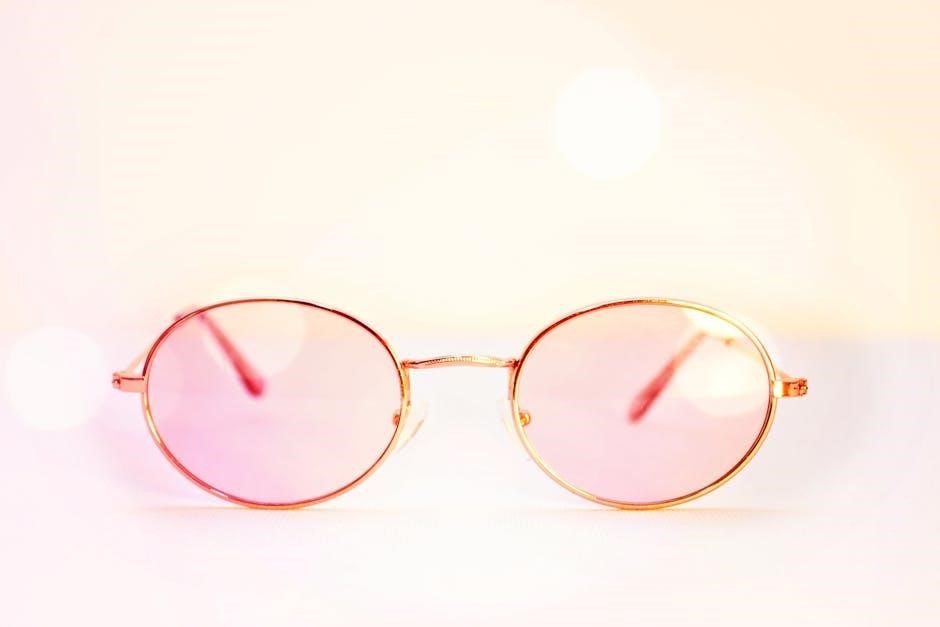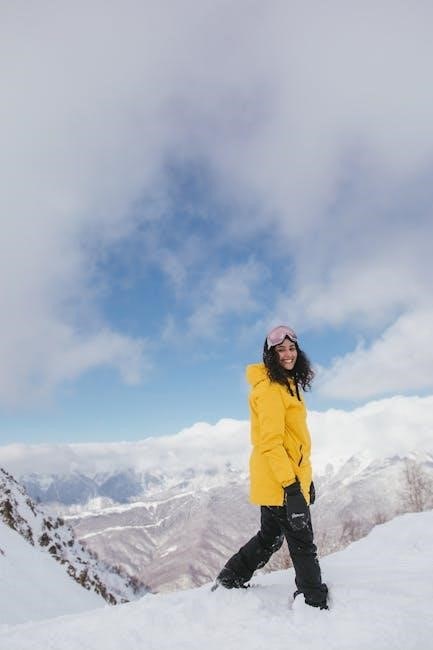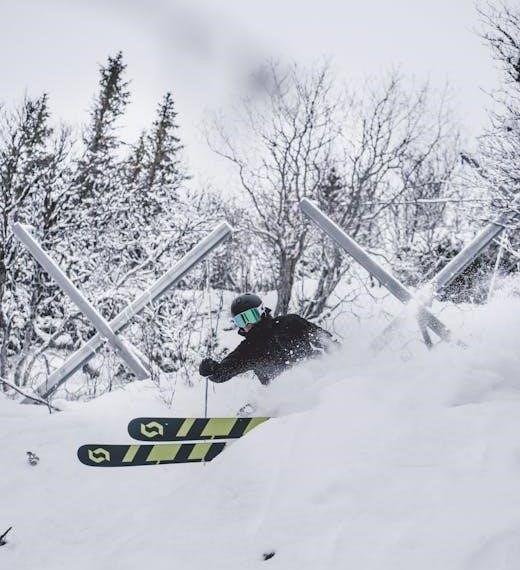ski goggles lens colour guide
Choosing the right ski goggle lens color is crucial for optimal visibility․ Lens tints affect light transmission, contrast, and glare reduction․ This guide explores how different colors enhance performance in varying snow conditions, helping you make informed decisions for clearer vision on the slopes․
Understanding the Importance of Lens Color in Skiing
Lens color plays a vital role in skiing, as it directly impacts visibility, glare reduction, and overall performance․ Different tints are designed to enhance vision in specific light conditions, ensuring clarity and contrast․ For instance, brighter days require darker tints to minimize glare, while low-light conditions benefit from lighter tints that allow more light to pass through․ The right lens color can improve depth perception, reduce eye strain, and enhance safety by optimizing visual clarity․ Whether skiing in sunny, cloudy, or flat-light conditions, the appropriate lens tint ensures better navigation and reaction time․ This guide will help you understand how lens colors work and why they are essential for maximizing your skiing experience․
Visual Light Transmission (VLT): What You Need to Know
Visual Light Transmission (VLT) measures the percentage of light passing through a lens․ Higher VLT allows more light, enhancing visibility in low-light conditions, while lower VLT reduces glare in bright environments․
How VLT Affects Visibility in Different Light Conditions
Visual Light Transmission (VLT) significantly impacts visibility by regulating the amount of light that reaches your eyes․ In low-light conditions, such as cloudy or overcast days, higher VLT lenses (like yellow, amber, or rose-tinted goggles) are advantageous․ These lenses allow more light to pass through, enhancing visibility and contrast, which is crucial for navigating flat light or snowy environments where depth perception can be challenging․
In bright, sunny conditions, lower VLT lenses (such as brown, black, or gray tints) are preferable․ These lenses reduce glare from sunlight reflecting off snow, minimizing eye strain and improving visual clarity․ Additionally, some lenses feature mirror coatings that further reduce glare, enhancing comfort and vision in intense light․
Understanding VLT is essential for selecting goggles that optimize your vision across various lighting conditions, ensuring a safer and more enjoyable skiing experience․

Ski Goggles for Low Light Conditions
Yellow, amber, and rose-tinted lenses excel in low-light settings, offering higher VLT for enhanced visibility and contrast, making them ideal for cloudy or overcast skiing conditions․
Yellow, Amber, and Rose-Colored Lenses: Best for Cloudy Days
Yellow, amber, and rose-colored lenses are ideal for cloudy days due to their ability to enhance contrast and visibility in low-light conditions․ These tints increase Visual Light Transmission (VLT), allowing more light to pass through the lens, which is crucial when the sky is overcast․ They help skiers distinguish between snow textures and obstacles more easily, reducing eye strain․ Amber lenses slightly enhance color contrast, while rose-tinted options provide a balanced view without distorting natural colors․ These lens colors are particularly beneficial in flat light and snowy environments, where visibility is reduced․ By improving clarity and definition, yellow, amber, and rose lenses ensure better performance on cloudy or low-light skiing days, making them a versatile choice for skiers who frequently encounter such conditions․
Why Orange-Based Lenses Excel in Flat Light and Snowy Conditions
Orange-based lenses are highly effective in flat light and snowy conditions due to their ability to enhance contrast and improve visibility․ These tints amplify the definition between snow textures, making it easier to navigate challenging terrain․ They work particularly well in overcast skies, where light is diffused, by adding warmth to the scene and reducing eye strain․ Orange lenses also excel in snowy environments, as they help skiers distinguish subtle changes in snow depth and texture․ Their moderate to high VLT ensures sufficient light transmission while maintaining clarity․ This makes orange-based lenses a versatile choice for skiers facing low-light or flat-light conditions, providing better depth perception and reducing the risk of missing obstacles․ Their performance in such scenarios makes them a popular option among skiers seeking reliable vision in challenging weather conditions․

Ski Goggles for Sunny Conditions
For sunny conditions, darker tints like brown, black, or gray are ideal․ These lenses reduce glare, offering sharper vision and UV protection․ Blue and purple options enhance navigation․
Brown, Black, and Gray Lenses: Reducing Glare in Bright Light
Brown, black, and gray lenses are designed to excel in sunny conditions by reducing glare and minimizing eye strain․ These darker tints have lower Visual Light Transmission (VLT), which means less light passes through the lens, providing better contrast and sharper vision․ Brown lenses, in particular, enhance color definition, making it easier to spot terrain features․ Black and gray lenses are ideal for extreme brightness, as they significantly reduce glare from snow and sunlight․ These options are perfect for skiers who prioritize UV protection and clarity on bluebird days․ While they may not perform well in low-light conditions, their ability to handle bright environments makes them a top choice for sunny slopes․
Blue and Purple Lenses: Enhancing Navigation in Sunny Environments
Blue and purple lenses are popular among skiers and snowboarders for their ability to enhance navigation in sunny conditions․ These tints work by reducing glare and improving contrast, which helps skiers better distinguish between snow textures and terrain features․ The blue tint is particularly effective at reducing glare from sunlight reflecting off snow, while purple lenses add a touch of contrast enhancement, making it easier to spot shadows and bumps․ Both colors are ideal for bright, sunny days and provide excellent UV protection․ While they may not perform as well in low-light conditions, their ability to maintain clarity and reduce eye strain in sunny environments makes them a great choice for skiers who frequently ski in clear, bluebird conditions․ Their unique tinting helps improve overall navigation and precision on the slopes․

Ski Goggles for Flat Light and Overcast Days
Yellow, rose, and orange-based lenses excel in flat light and overcast conditions, offering increased VLT for better visibility and contrast to enhance performance in low-light environments․
The Benefits of Yellow and Rose-Colored Lenses in Low Visibility
Yellow and rose-colored lenses are designed to enhance visibility in low-light conditions by increasing Visual Light Transmission (VLT)․ These tints amplify available light, improving contrast and reducing haze․ They are particularly effective on overcast days or in flat light, where natural brightness is limited․ By boosting contrast, these lenses help skiers distinguish terrain features more clearly, reducing eye strain and improving reaction time․ Additionally, they reduce glare from snow surfaces, providing sharper vision․ Yellow lenses are often preferred in snowy conditions, while rose-colored options offer a balance between light enhancement and color accuracy․ Both are ideal for skiers who frequently encounter cloudy or low-light environments, ensuring better clarity and safety on the slopes․

Choosing the Best Lens Color for Your Skiing Needs
Selecting the right lens color depends on light conditions, terrain, and personal preference․ Consider VLT, glare reduction, and contrast enhancement to optimize visibility and comfort on the slopes․
How to Select Lenses Based on Weather and Light Conditions
Choosing the right lens color for your ski goggles involves matching the tint to the weather and light conditions you’ll encounter․ For low-light or overcast days, opt for lenses with higher Visual Light Transmission (VLT), such as yellow, amber, or rose-colored options, which enhance visibility and contrast․ In sunny conditions, darker tints like brown, black, or gray are ideal as they reduce glare and protect your eyes from intense light․ For flat light or snowy environments, orange-based or yellow lenses improve definition and reduce eye strain․ Blue and purple lenses can enhance navigation in bright, sunny conditions by reducing glare from snow․ Consider interchangeable lenses if you ski in varying conditions․ Always prioritize VLT percentages and glare reduction based on your skiing environment to ensure optimal clarity and comfort․
Selecting the right ski goggle lens color is essential for enhancing your skiing experience․ Whether you’re navigating low-light conditions or soaking up the sun on a bright day, the correct tint ensures optimal visibility and comfort․ By understanding how lens colors like yellow, amber, rose, brown, black, gray, blue, and purple perform in different environments, you can make informed decisions tailored to your skiing needs․ Higher VLT options excel in cloudy or flat-light settings, while darker tints reduce glare in sunny conditions․ Investing in goggles with interchangeable lenses offers versatility for varying weather․ Ultimately, the perfect pair will enhance your vision, reduce eye strain, and boost your confidence on the slopes․ Choose wisely, and get ready to elevate your next ski adventure with crystal-clear clarity and style!
